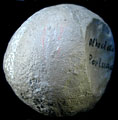The Echinoid Directory
Gymnodiadema de Loriol, 1884, p. 606
| Diagnostic Features |
|
|---|---|
| Distribution | Middle Jurassic (Callovian), Portugal. |
| Name gender | neuter |
| Type | Gymnodiadema choffati de Loriol, 1884. p. 606. Plastercast of holotype: Museum d\'Histoire Naturelle, Geneva 26022. |
| Species Included |
|
| Classification and/or Status |
|
| Remarks |
|




